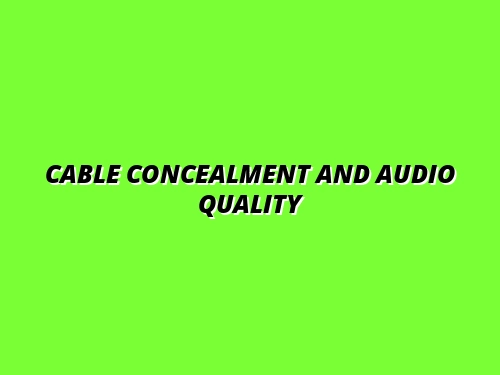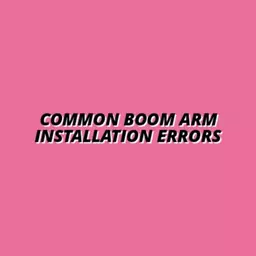Have you ever wondered why some audio setups sound crystal clear while others fall flat? The difference might just lie in how well the cables are concealed and managed. In this article, we uncover the often-overlooked connection between cable concealment and audio quality, revealing practical insights that can transform your audio experience.
Key Takeaways
- Cable Length and Quality Matter: Shorter, high-quality cables reduce signal loss and ensure better sound performance.
- Effective Concealment Minimizes Interference: Proper cable management helps reduce unwanted noise and electromagnetic interference, enhancing audio clarity.
- Proper Installation Techniques are Crucial: The way you route and conceal your cables can significantly impact audio clarity and performance.
- Choosing the Right Cables: Utilizing high-quality cables tailored for specific audio needs helps maintain superior sound quality.
Key Takeaways on Cable Management and Audio Performance
These essential points highlight the importance of cable concealment and its impact on audio quality.
Cable Length and Quality Matter
Shorter, high-quality cables reduce signal loss and ensure better sound.
Effective Concealment Minimizes Interference
Managing cables properly helps reduce unwanted noise and electromagnetic interference.
Proper Installation Techniques are Crucial
How you route and conceal your cables can impact audio clarity significantly.
Choosing the Right Cables
Use high-quality cables designed for your specific needs to maintain superior sound quality.
The Connection Between Cable Concealment and Audio Quality
When we talk about audio quality, many factors come into play, and one often overlooked aspect is cable concealment. At Tidy Audio Desk, I’ve seen how a well-organized setup can significantly enhance sound performance. But how exactly does hiding those cables improve audio clarity? Let’s delve into this crucial connection!
Understanding Audio Quality: Key Factors at Play
To grasp the significance of cable concealment, we first need to define what makes audio quality exceptional. It’s not just about the equipment but also how everything is connected. Here are some essential factors that impact audio quality:
- Microphone Quality: A high-quality microphone captures sound better.
- Room Acoustics: The space where you record can alter sound perception.
- Cable Quality: The type and length of cables can affect signal integrity.
Defining Audio Quality: What Matters Most?
Audio quality can be subjective, but it generally revolves around clarity and faithfulness to the original sound. Clear sound without distortion is what you aim for. Think about your favorite podcast or music track. How crisp and vibrant do the sounds need to be to keep you engaged?
Influence of Cable Length and Quality on Sound
Have you ever noticed that longer cables might lead to a loss of sound quality? This phenomenon, known as signal attenuation, can make your audio less vibrant. Using high-quality cables of appropriate lengths is crucial to maintaining audio integrity. So, choose wisely when setting up your audio environment! One way to ensure optimal sound is to use neat desktop audio cable solutions, which help manage cable length and quality effectively.
💡 Planning an echo-free audio desk? Start with desk setup inspiration and acoustic routing. 👉 Explore the Setup Ideas Guide
The Role of Cable Concealment in Audio Systems
Cable concealment is more than just keeping a tidy workspace; it directly impacts how your audio system performs. Proper cable management helps prevent tangles and reduces the chances of interference. This can make a noticeable difference in your audio experience, especially when you are streaming or podcasting.
What is Cable Concealment and Why is It Important?
Simply put, cable concealment refers to the techniques used to hide or organize cables within your audio setup. It’s important because:
- Reduces Clutter: A tidy workspace is more inviting and functional.
- Enhances Performance: Less visible cables can mean less interference.
- Improves Aesthetics: A neat appearance boosts the professional look of your space.
FAQs About Cable Concealment and Audio Quality
-
Why is cable concealment important for audio quality?
Cable concealment minimizes interference, reduces clutter, and enhances the overall performance and aesthetics of your audio setup.
-
How does cable length affect audio quality?
Longer cables can lead to signal attenuation, reducing audio quality. Using high-quality cables of appropriate lengths is crucial.
-
What are common sources of interference in audio systems?
Common sources include electromagnetic interference (EMI), radio frequency interference (RFI), and ground loops.
-
What types of cables are recommended for optimal audio performance?
Recommended cables include XLR cables for balanced audio connections, TRS cables for instruments and audio interfaces, and RCA cables for home theater systems.
-
What are practical solutions for cable concealment?
Effective methods include using under-desk cable trays, cable sleeves, and wall channels to maintain audio quality while keeping cables out of sight.
The Aesthetic and Functional Aspects of Cable Management
Good cable management makes your setup look polished and can also enhance functionality. Imagine walking into a room where the cables are hidden away, creating a seamless vibe. Not only does it make a great first impression, but it also helps you focus on your work, rather than the mess around you!
Signal Attenuation: How Concealment Affects Audio Clarity
Next, let’s dive into signal attenuation—this is where things get interesting! Concealing your cables can significantly affect the clarity of your audio. How does this happen? Let’s break it down.
Understanding Signal Attenuation and Its Implications
Signal attenuation refers to the reduction in signal strength as it travels through a cable. This can occur due to various factors such as cable length and quality. When cables are concealed properly, they can be routed efficiently, reducing the chance of interference and preserving signal quality. Want to ensure your cables are perfectly routed? Consider exploring simple cable routing for boom arms and other setups for optimal audio performance.
The Impact of Concealing Cables on Signal Strength
When your cables are hidden and managed well, you create a more efficient audio path. This can help maintain the signal’s integrity, leading to a cleaner sound. Think of it like water flowing through a pipe—the smoother the path, the less resistance there is!
Minimizing Noise and Interference Through Effective Concealment
All audio systems face challenges from noise and interference. But don’t worry! Effective cable concealment techniques can minimize these issues significantly.
How Shielding Techniques Enhance Audio Signal Integrity
Using shielded cables can greatly enhance audio signal integrity. At Tidy Audio Desk, we emphasize that proper shielding not only protects against external interference but also keeps your audio signal clean and clear. This is crucial for streamers and podcasters who rely on high-quality sound.
Common Sources of Interference in Audio Systems
Understanding where interference comes from can help you design a better audio setup. Here are some common sources:
- Electromagnetic Interference (EMI): Caused by devices like routers and microwaves.
- Radio Frequency Interference (RFI): Can arise from nearby radio towers.
- Ground Loops: Often result from improper grounding of equipment.
Impact of Electromagnetic Interference (EMI) on Audio Performance
EMI can lead to unwanted noise and distortion in your sound. By effectively concealing and managing your cables, you create a barrier against these pesky interferences, ensuring that your audio quality remains top-notch!
Choosing High-Quality Cables for Optimal Performance
The quality of your cables plays a crucial role in your audio performance. But what should you look for? Let’s explore the essentials!
Importance of Cable Material and Design
Not all cables are created equal! Cables made from high-quality materials, such as oxygen-free copper, can significantly improve sound clarity. Additionally, their design—like the thickness and shielding—can affect how well they perform in your audio setup.
Recommended Cable Types for Concealment and Performance
When it comes to choosing cables, here are some of my top recommendations:
- XLR Cables: Great for balanced audio connections.
- TRS Cables: Ideal for instruments and audio interfaces.
- RCA Cables: Commonly used for home theater systems.
Comparison of Digital vs. Analog Cables in Audio Systems
Understanding the difference between digital and analog cables can help you make informed choices. Digital cables typically offer cleaner sound and less interference, while analog cables can give a warmer tone. Your choice depends on your specific audio needs!
Understanding Balanced vs. Unbalanced Cables for Superior Sound Quality
Lastly, let’s discuss balanced versus unbalanced cables. Balanced cables are excellent for minimizing noise, especially over long distances. Discover hidden XLR routing in streaming setups for superior sound quality if you're looking for pro-level clarity.
Practical Solutions for Cable Concealment Without Compromising Quality
Now that we’ve explored the importance of cable concealment, let’s look at some practical solutions to implement in your audio setup.
Effective Methods to Conceal Cables in Different Settings
There are several methods to conceal cables while maintaining their quality:
- Under Desk Cable Trays: Perfect for keeping cables out of sight.
- Cable Sleeves: They keep cables bundled and organized.
- Wall Channels: Great for running cables along walls!
How to Maintain Audio Quality While Concealing Cables
Ensure that your cables are not pinched or kinked during concealment. This helps maintain their integrity and prevents any loss of sound quality. It’s all about balance—keeping things tidy while ensuring top performance!
Installation Techniques for Efficient Cable Routing and Management
When installing your audio setup, consider the paths your cables will take. Using clips or ties can help keep them in place and prevent tangles. A well-planned routing system can make all the difference in both aesthetics and performance!
Real-World Examples: Case Studies on Cable Concealment
To illustrate the points we've discussed, let’s look at some real-world examples of successful audio setups that utilize effective cable concealment.
Analyzing Successful Audio Setups with Concealed Cables
Many professional audio creators have embraced cable concealment to enhance their work environments. For instance, streamers who hide their cables in wall channels report fewer interruptions from cable tangles and interference. This keeps their focus on creating amazing content!
Lessons Learned from Audio Professionals
Audio professionals consistently emphasize the importance of organization. Many recommend investing in quality cables and effective concealment solutions to avoid costly mistakes in the long run.
Showcasing Home Theater Systems and Their Cable Management Solutions
Home theater setups can also benefit from effective cable management. Using cable sleeves and dedicated trays, homeowners have successfully created sleek environments that not only look good but also sound fantastic!
In conclusion, the connection between cable concealment and audio quality is profound. By focusing on effective management and high-quality materials, you’ll create an audio environment that not only looks tidy but also performs beautifully. Ready to tidy up your audio desk and enhance your sound experience? Let's get started today!
Pro Tip
Did you know? Investing in high-quality cables not only enhances audio clarity but also minimizes the risk of interference. When concealing cables, always opt for shielded options to protect against electromagnetic interference (EMI) and radio frequency interference (RFI). This small upgrade can lead to a significant improvement in your audio experience!
Summarizing the Impact of Cable Concealment on Audio Quality
As we wrap up our exploration of cable concealment and its effect on audio quality, it's essential to consider the many ways a tidy setup can enhance sound performance. From maintaining signal integrity to reducing clutter, effective cable management is not just about aesthetics—it's about creating a seamless audio experience. As someone deeply invested in audio solutions at Tidy Audio Desk, I can attest that the right approach to concealment can make a world of difference!
Remember, the primary takeaway is that **proper cable management plays a vital role** in optimizing audio performance. Whether you're a podcaster, streamer, or audio professional, understanding how to effectively conceal cables can help you achieve that crisp, clear sound you desire. Let’s take a closer look at some key points that summarize our findings.
Key Takeaways on Cable Management and Audio Performance
In summary, the interplay between cable concealment and audio quality is significant. Here are the essential takeaways that can enhance your audio setup:
- Cable Length and Quality Matter: Shorter, high-quality cables reduce signal loss and ensure better sound.
- Effective Concealment Minimizes Interference: Managing cables properly helps reduce unwanted noise and electromagnetic interference.
- Proper Installation Techniques are Crucial: How you route and conceal your cables can impact audio clarity significantly.
- Choosing the Right Cables: Use high-quality cables designed for your specific needs to maintain superior sound quality.
These takeaways not only highlight the importance of cable concealment but also emphasize how it can elevate your overall audio experience. As you consider your own setup, think about how these points can guide your choices in cable management.
Final Insights on Signal Integrity and Concealment
Ultimately, maintaining signal integrity is paramount. Concealed cables should not compromise performance; they should enhance it! By utilizing effective shielding techniques and selecting quality materials, you can create an audio environment that excels in clarity and functionality. It's all about striking that perfect balance between aesthetics and performance.
Have you thought about how this applies to your own workspace? Reflecting on your current setup might reveal areas for improvement, whether it’s rearranging your cables or investing in better quality components. I encourage you to take a moment and envision how a tidy audio desk can transform your sound experience!
Exploring Connectivity Issues in Home Audio Setups
Connectivity issues can often throw a wrench into your audio plans. It's vital to recognize common problems that might arise when setting up your A/V equipment. Here's a look at some frequent connectivity challenges:
- Loose Connections: Ensuring that connectors are tightly secured can significantly improve performance.
- Incompatibility: Some devices may not work well together, leading to poor audio quality.
- Incorrect Cable Types: Using the wrong type of cable can lead to signal loss and degradation.
Each of these issues can affect your audio clarity and overall experience. By understanding these potential pitfalls, you can better prepare and address them, ensuring that your audio setup delivers the best performance possible.
Understanding Impedance Matching for Optimal Audio Signal
Another critical aspect of audio setups is impedance matching. This concept helps ensure that your components work together efficiently, producing the best sound quality. When components are properly matched, signals travel more effectively, enhancing the overall listening experience. If you’re curious about how to achieve the best impedance, I’d be happy to help guide you in selecting the right equipment!
Resources for Advanced Learning on Cable Technologies
For those eager to dive deeper into cable technologies, there are numerous resources available that can enhance your knowledge. Here are some recommendations to consider:
- Audio Cable Reviews: Websites and forums dedicated to audio gear can provide insights and user experiences about different cable types.
- Professional Insights: Many audio professionals share their experiences and recommendations, which can be invaluable for anyone looking to improve their setup.
- Online Courses and Webinars: These can be a great way to learn about advanced techniques and technologies in the audio industry.
By exploring these resources, you can equip yourself with the knowledge needed to make informed decisions about your audio setup. At Tidy Audio Desk, we’re committed to helping you find the right solutions for your audio needs. Whether you’re just starting out or looking to enhance an existing setup, we’re here to support your journey!
Recap of Key Points
Here is a quick recap of the important points discussed in the article:
- Cable Length and Quality Matter: Shorter, high-quality cables reduce signal loss and ensure better sound.
- Effective Concealment Minimizes Interference: Proper cable management helps reduce unwanted noise and electromagnetic interference.
- Proper Installation Techniques are Crucial: How you route and conceal your cables can significantly impact audio clarity.
- Choosing the Right Cables: Use high-quality cables designed for your specific needs to maintain superior sound quality.
- Signal Integrity is Paramount: Concealed cables should enhance, not compromise, performance through effective shielding and quality materials.
For ideas on managing cables for desk lamps, check out desk lamp cable organization ideas for some practical tips.
Also, if you're aiming for a streamlined setup, explore how to streamline cables at your desk for enhanced efficiency.










